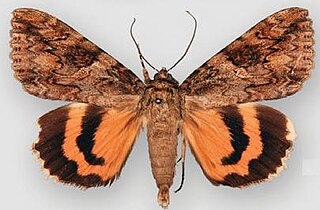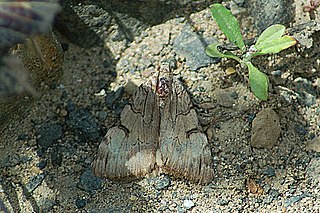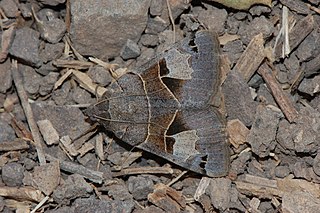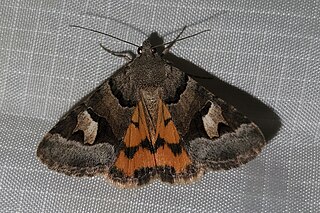
Emil von Behring, born Emil Adolf Behring, was a German physiologist who received the 1901 Nobel Prize in Physiology or Medicine, the first one awarded in that field, for his discovery of a diphtheria antitoxin. He was widely known as a "saviour of children", as diphtheria used to be a major cause of child death. His work with the disease, as well as tetanus, has come to bring him most of his fame and acknowledgment. He was honoured with Prussian nobility in 1901, henceforth being known by the surname "von Behring."

Puyi, was the final emperor of China, reigning as the eleventh and final monarch of the Qing dynasty. He was later ruler of the puppet state of Manchukuo under the Empire of Japan from 1934 to 1945. He became emperor at the age of two in 1908, but was forced to abdicate at the age of six in 1912 during the Xinhai Revolution. During his first reign he was known as the Xuantong Emperor, with his era name meaning "proclamation of unity".

Apodemia is a New World genus of metalmark butterflies found from Canada to Brazil.

Ira Steven Behr is an American screenwriter and television producer, best known for his work on Star Trek, especially Star Trek: Deep Space Nine, on which he served as showrunner and executive producer. He was the executive producer and showrunner on Crash, executive producer on Syfy's Alphas and a writer and co-executive producer on Outlander.

Bulia is a genus of moths in the family Erebidae.

Drasteria is a genus of moths in the family Erebidae.

Bulia deducta is a moth of the family Erebidae first described by Herbert Knowles Morrison in 1875. It is found from central Mexico north to central California, Utah, Wyoming and Nebraska, east to Arkansas and Alabama.
Bulia similaris is a species of moth of the family Erebidae. It is found from southern California south to Baja California, east to southern Arizona, northwestern Sonora, western Texas and eastern Mexico.
Bulia schausi is a moth of the family Erebidae. It is found in north-western Mexico, with strays as far north as Arizona, though it was first found in Tehuacan, Mexico.

Bulia confirmans is a moth of the family Erebidae. It is found in Cuba, Jamaica, Haiti, the Dominican Republic, Puerto Rico, Grenada, northern Venezuela and Colombia.

Catocala irene, or Irene's underwing, is a moth of the family Erebidae first described by Hans Hermann Behr in 1870. It is found in the western United States in Utah and California and Nevada.

Drasteria adumbrata, the shadowy arches, is a moth of the family Erebidae. The species was first described by Hans Hermann Behr in 1870. It is found from coast to coast in southern Canada, south in the west to California and Colorado, south in the east to New England and Michigan. Subspecies D. a. alleni is found from eastern Alberta to New York and Nova Scotia. Subspecies D. a. saxea occurs from southern British Columbia and south-west Alberta south to California and Colorado.

Drasteria divergens is a moth of the family Erebidae. It is found from California to Colorado, north to British Columbia.

Drasteria ochracea is a moth of the family Erebidae. It is found from British Columbia south through the western parts of the United States from Washington south to Arizona.
Drasteria tejonica is a moth of the family Erebidae. It has been recorded from California, Arizona, Colorado, Utah and New Mexico.

Drasteria edwardsii is a moth of the family Erebidae. It is found from Washington, through Oregon to California.

Fjotolf Hansen, better known by his birth name Anders Behring Breivik, is a Norwegian neo-Nazi terrorist. He is known primarily for committing the 2011 Norway attacks on 22 July 2011, in which he killed eight people by detonating a van bomb at Regjeringskvartalet in Oslo, and then killed 69 participants of a Workers' Youth League (AUF) summer camp, in a mass shooting on the island of Utøya.
Drasteria maculosa is a moth of the family Erebidae. It is found in North America, where it has been recorded from Nevada and California.

Drasteria stretchii is a species of moth in the family Erebidae. It is found in North America, where it has been recorded from northern Nevada., California, Oregon, Wyoming and Washington. The habitat consists of dry, rocky canyons at low to middle elevations.

The Korean People's Association in Manchuria was a self-governing autonomous prefecture in Manchuria, populated by two million Korean refugees. Following the Japanese occupation of Korea, many Korean anarchists had fled over the border into Manchuria, where they began organising a network of mutual aid for displaced Koreans in the region. Together with some Korean nationalists, they established the KPAM in order to provide food, education and self-defence to its members. Before long, the association found itself under attack by both Korean communists and Japanese imperialists, who assassinated their leadership. The Japanese invasion of Manchuria put an end to the anarchist experiment, with many of its members fleeing to China in order to fight against the Japanese Empire.
















